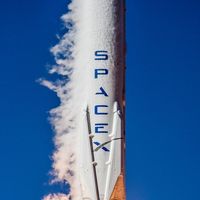Astronaut's Return: A Journey from Space to Safety
October 28, 2024, 4:02 pm

Location: United States, District of Columbia, Washington
Employees: 5001-10000
Founded date: 2002
Total raised: $7.53B

Location: United States, Maryland, Greenbelt
Employees: 10001+
Founded date: 1958
Total raised: $25.7B
The cosmos is a vast expanse, a realm of stars and silence. For astronauts, it’s a dream come true. But returning to Earth can be a turbulent ride. Recently, the SpaceX Crew-8 mission highlighted this reality. After 236 days in space, the crew faced an unexpected challenge upon their return.
On October 25, 2024, the Crew Dragon capsule splashed down in the ocean. The landing was smooth, a delicate ballet of technology and precision. Yet, not all was well. One astronaut required hospitalization. The crew was whisked away to a Florida hospital as a precaution. Safety first, always.
NASA confirmed the incident. The astronaut, whose identity remains confidential, was under medical observation. Initial assessments showed stability. This was a relief. The return from microgravity can be a shock to the body. The transition is often fraught with complications. Doctors monitor astronauts closely during this period.
The Crew-8 team included notable names: Matthew Dominick, Michael Barrett, Jeanette Epps, and Russian cosmonaut Alexander Grebennikin. Each member carries the weight of their mission. They are pioneers, explorers of the unknown. Their journey through the stars is a testament to human ingenuity.
After spending months aboard the International Space Station (ISS), the crew faced the harsh reality of gravity. The return to Earth is not just a physical journey; it’s a mental one. The body must readjust. Muscles weaken in microgravity. Bones lose density. It’s a slow road back to normalcy.
NASA’s medical team is well-prepared for these challenges. They work with astronauts individually, tailoring recovery plans. Typically, it takes months for astronauts to regain their pre-flight condition. The body needs time to adapt. It’s a process, not a race.
The Crew Dragon’s landing was not without its hiccups. NASA noted minor issues with the capsule’s parachutes. The small braking parachutes and the main parachute showed slight irregularities. However, these did not compromise the landing. The capsule still touched down safely, a testament to SpaceX’s engineering.
Following the incident, the hospitalized astronaut was released the next day. On October 26, NASA announced his discharge. He was in good health, ready to continue recovery at the Johnson Space Center in Houston, Texas. The swift action of medical personnel ensured a positive outcome.
NASA emphasized the importance of confidentiality. The agency refrained from disclosing specific details about the astronaut’s condition. This respect for privacy is crucial in the tight-knit community of space explorers. Each astronaut’s journey is unique, and their stories deserve protection.
The Crew-8 mission faced delays before its launch. Originally scheduled for October 8, weather conditions forced multiple rescheduling. Space travel is often at the mercy of nature. The launch finally took place on October 23, with the capsule detaching from the ISS.
As the Crew Dragon returned, the world watched. The mission was a success, despite the challenges. SpaceX continues to push boundaries, redefining space travel. Each mission brings new lessons, new data, and new stories.
The journey from space to Earth is a reminder of our fragility. Astronauts are heroes, but they are also human. They face risks that most can only imagine. Their bravery is matched by the teams that support them. Engineers, scientists, and medical professionals work tirelessly behind the scenes.
The Crew-8 mission serves as a beacon of hope. It showcases the resilience of the human spirit. The astronaut’s hospitalization was a moment of concern, but it also highlighted the robust safety protocols in place. Space travel is an adventure, but safety is paramount.
As the astronaut continues recovery, the world looks forward to future missions. The cosmos beckons. Each journey into space is a step into the unknown. It’s a dance with the stars, a quest for knowledge.
NASA and SpaceX are committed to exploring this frontier. They push the limits of what is possible. The challenges faced by Crew-8 are part of a larger narrative. It’s a story of exploration, courage, and the relentless pursuit of discovery.
In the end, the return from space is more than just a landing. It’s a reminder of our connection to the universe. Each astronaut carries a piece of that vastness within them. They are ambassadors of Earth, sharing their experiences and insights.
As we look to the future, we celebrate the triumphs of missions like Crew-8. They inspire generations to dream big. The stars are not just distant points of light; they are destinations waiting to be explored.
The journey continues. The cosmos awaits.
On October 25, 2024, the Crew Dragon capsule splashed down in the ocean. The landing was smooth, a delicate ballet of technology and precision. Yet, not all was well. One astronaut required hospitalization. The crew was whisked away to a Florida hospital as a precaution. Safety first, always.
NASA confirmed the incident. The astronaut, whose identity remains confidential, was under medical observation. Initial assessments showed stability. This was a relief. The return from microgravity can be a shock to the body. The transition is often fraught with complications. Doctors monitor astronauts closely during this period.
The Crew-8 team included notable names: Matthew Dominick, Michael Barrett, Jeanette Epps, and Russian cosmonaut Alexander Grebennikin. Each member carries the weight of their mission. They are pioneers, explorers of the unknown. Their journey through the stars is a testament to human ingenuity.
After spending months aboard the International Space Station (ISS), the crew faced the harsh reality of gravity. The return to Earth is not just a physical journey; it’s a mental one. The body must readjust. Muscles weaken in microgravity. Bones lose density. It’s a slow road back to normalcy.
NASA’s medical team is well-prepared for these challenges. They work with astronauts individually, tailoring recovery plans. Typically, it takes months for astronauts to regain their pre-flight condition. The body needs time to adapt. It’s a process, not a race.
The Crew Dragon’s landing was not without its hiccups. NASA noted minor issues with the capsule’s parachutes. The small braking parachutes and the main parachute showed slight irregularities. However, these did not compromise the landing. The capsule still touched down safely, a testament to SpaceX’s engineering.
Following the incident, the hospitalized astronaut was released the next day. On October 26, NASA announced his discharge. He was in good health, ready to continue recovery at the Johnson Space Center in Houston, Texas. The swift action of medical personnel ensured a positive outcome.
NASA emphasized the importance of confidentiality. The agency refrained from disclosing specific details about the astronaut’s condition. This respect for privacy is crucial in the tight-knit community of space explorers. Each astronaut’s journey is unique, and their stories deserve protection.
The Crew-8 mission faced delays before its launch. Originally scheduled for October 8, weather conditions forced multiple rescheduling. Space travel is often at the mercy of nature. The launch finally took place on October 23, with the capsule detaching from the ISS.
As the Crew Dragon returned, the world watched. The mission was a success, despite the challenges. SpaceX continues to push boundaries, redefining space travel. Each mission brings new lessons, new data, and new stories.
The journey from space to Earth is a reminder of our fragility. Astronauts are heroes, but they are also human. They face risks that most can only imagine. Their bravery is matched by the teams that support them. Engineers, scientists, and medical professionals work tirelessly behind the scenes.
The Crew-8 mission serves as a beacon of hope. It showcases the resilience of the human spirit. The astronaut’s hospitalization was a moment of concern, but it also highlighted the robust safety protocols in place. Space travel is an adventure, but safety is paramount.
As the astronaut continues recovery, the world looks forward to future missions. The cosmos beckons. Each journey into space is a step into the unknown. It’s a dance with the stars, a quest for knowledge.
NASA and SpaceX are committed to exploring this frontier. They push the limits of what is possible. The challenges faced by Crew-8 are part of a larger narrative. It’s a story of exploration, courage, and the relentless pursuit of discovery.
In the end, the return from space is more than just a landing. It’s a reminder of our connection to the universe. Each astronaut carries a piece of that vastness within them. They are ambassadors of Earth, sharing their experiences and insights.
As we look to the future, we celebrate the triumphs of missions like Crew-8. They inspire generations to dream big. The stars are not just distant points of light; they are destinations waiting to be explored.
The journey continues. The cosmos awaits.